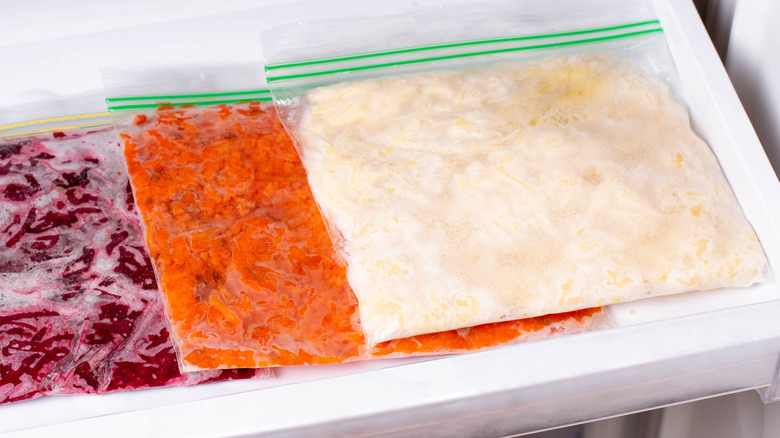How To Freeze Any Potato Salad, Store-Bought Or Homemade
Creamy potato salad is great for feeding a crowd, whether at a potluck or a picnic. But no matter how delicious the homemade recipe is — or how good the store-bought version tastes — you're likely to end up with leftovers.
When it comes to storing mayonnaise-based potato salad in the fridge, it can last up to three or four days, provided it has been cooled to 70 degrees Fahrenheit within two hours and to 41 degrees Fahrenheit within four hours of preparation. But can you freeze potato salad to extend its lifespan? The short answer is yes, but the longer answer is that it's a bit more complicated.
If you plan to freeze potato salad, it's best to do so as soon as possible after making or buying it. You should also freeze it in a flat, single layer to maintain as much of its textural integrity as possible when it thaws. Sturdier potato varieties like red-skinned or Yukon Gold are likely to fare better during the freezing process. It's also important to consider the ingredients in the dish. Freezing a potato salad made with mayonnaise will alter the texture, look, and taste, making it less appetizing once thawed. However, it's still possible to freeze it with some tips and tricks — just make sure to store it in a freezer-safe bag, and serve it warm when it's time to eat.
Freeze potato salad in a single layer for better texture
Freezing potato salad is not ideal, particularly when it's made with mayonnaise. Mayonnaise consists of an emulsion of oil, egg yolks, and vinegar (or lemon juice). When thawed, this emulsion tends to separate, resulting in a curdled texture. Other dairy ingredients, such as sour cream, can pose similar challenges. Although oil-based dressings may freeze more successfully, the dish could still experience a decline in taste and texture and might even take on a gray hue, which is hardly appealing. However, that doesn't mean freezing potato salad is impossible.
Whether your potato salad is homemade or store-bought, the key to freezing it successfully is to store it in a single layer. This approach helps it thaw more quickly and minimizes the risk of textural spoilage, which can occur when the salad is stored as a block and the middle stays frozen for a longer period. For homemade potato salad, place it in a freezer-safe bag in a single layer, squeeze out as much air as possible, mark the bag with the date, and lay it flat in the freezer. For store-bought potato salad, transfer it to a freezer-safe bag and follow the same method. Stored this way, potato salads can last around three months in the freezer, though the less time they spend there, the better.
How to prepare potato salad that's been frozen
When it's time to serve the frozen potato salad, it will first need to be thawed. The best method is to thaw it overnight in the refrigerator. If you're short on time, you can also defrost the fully sealed bag in cold water.
While the thawed potato salad may not look as appealing, especially if the texture has split, the mayonnaise in the dish is still safe to eat. A careful stir can help redistribute the dressing, and adding a little more mayonnaise, mustard, or vinegar can help restore some of the original flavor. You can also warm up a mayo-based frozen potato salad.
Vinegar-based dressings, like those in German or French styles — such as Ina Garten's French potato salad — tend to fare better during the freezing and thawing processes. Stirring the dish can help recover some texture if it has separated. Though the potatoes may turn gray — and though the oil may look cloudy — vinegar-based salads should not lose much of their flavor. Ultimately, however, the best way to enjoy potato salad is fresh. So, having a second helping might be a better option than freezing it. And that's a pretty good excuse, at least.



